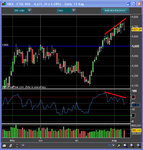Mr. G
Well-known member
- Messages
- 259
- Likes
- 3
Thanks Tom. A trader who ran a course I attended a numbers of years ago used to use a 22 day average as it is the average number of trading days in a month. Each to their own I suppose.
As always, I guess it's a case of finding something that works for you as an individual.
As always, I guess it's a case of finding something that works for you as an individual.

